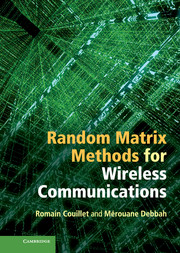Book contents
- Frontmatter
- Contents
- Preface
- Acknowledgments
- Acronyms
- Notation
- 1 Introduction
- Part I Theoretical aspects
- Part II Applications to wireless communications
- 11 Introduction to applications in telecommunications
- 12 System performance of CDMA technologies
- 13 Performance of multiple antenna systems
- 14 Rate performance in multiple access and broadcast channels
- 15 Performance of multi-cellular and relay networks
- 16 Detection
- 17 Estimation
- 18 System modeling
- 19 Perspectives
- 20 Conclusion
- References
- Index
17 - Estimation
from Part II - Applications to wireless communications
Published online by Cambridge University Press: 07 October 2011
- Frontmatter
- Contents
- Preface
- Acknowledgments
- Acronyms
- Notation
- 1 Introduction
- Part I Theoretical aspects
- Part II Applications to wireless communications
- 11 Introduction to applications in telecommunications
- 12 System performance of CDMA technologies
- 13 Performance of multiple antenna systems
- 14 Rate performance in multiple access and broadcast channels
- 15 Performance of multi-cellular and relay networks
- 16 Detection
- 17 Estimation
- 18 System modeling
- 19 Perspectives
- 20 Conclusion
- References
- Index
Summary
In this chapter, we consider the consistent estimation of system parameters involving random matrices with large dimensions. When it comes to estimation or statistical inference in signal processing, there often exists a large number of different methods proposed in the literature, most of which are usually based on a reference, simple, and robust method which has various limitations such as the Urkowitz's power detector [Urkowitz, 1967] that only assumes the additive white Gaussian noise (AWGN) model, or the multiple signal classification (MUSIC) algorithm [Schmidt, 1986] of Schmidt that suffers from undecidability issues when the signal to noise ratio reaches a critically low value. When performing statistical inference based on a limited number of large dimensional vector inputs, the main limitation is due to the fact that those legacy estimators are usually built under the assumption that the number of available observations is extremely large compared to the number of system parameters to identify. In modern signal processing applications, especially for large sensor networks, the estimators receive as inputs the M stacked N-dimensional observation vectors Y = [y(1),…,y(M)] ∈ ℂN × M of some observation vectors y(m) ∈ ℂ N at time m, M and N being of similar size, or even sometimes M being much smaller than N. Novel estimators that can cope with this large population size limitation are therefore required in place of the historical estimators.
Information
- Type
- Chapter
- Information
- Random Matrix Methods for Wireless Communications , pp. 421 - 476Publisher: Cambridge University PressPrint publication year: 2011
